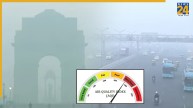New Delhi: In view of polluted air in the national capital, the Centre’s Commission for Air Quality Management (CAQM) directed that only electric, CNG, and BS VI-compliant diesel buses will run in Delhi-National Capital Region (NCR) from November 1.
The order will comply in the cities and towns in Haryana, Uttar Pradesh and Rajasthan, which come within NCR. Meanwhile, the Principal Secretaries and Transport Departments of Uttar Pradesh, Haryana and Rajasthan have been directed to list out all buses, which are originating or terminating in NCR. The decision has been taken in order to curb the air pollution in Delhi-NCR.
Starting from June 30, 2028, the Central Pollution Control Board (CPCB) has mandated that a significant portion of buses either originating from or arriving in the National Capital Region (NCR) should operate exclusively in Electric Vehicle (EV) mode.
Additionally, beginning July 1, 2024, all bus services traveling between towns or cities in Haryana, Rajasthan, and Uttar Pradesh to Delhi or other regions within the NCR are required to use Electric Vehicles (EV), Compressed Natural Gas (CNG), or Bharat Stage VI (BSVI) Diesel buses exclusively.
Delhi’s Environment Minister, Gopal Rai, has urged the central government to impose a strict ban on buses using low-quality diesel in the NCR areas of Haryana, Uttar Pradesh, and Rajasthan. During an unannounced inspection at the Kashmere Gate interstate bus terminal, Minister Rai discovered that all buses registered in Haryana, Rajasthan, and Uttar Pradesh were running on BS III and BS IV vehicles.
In October of this year, Delhi experienced its most severe air quality since 2020, with meteorologists linking the decline to the absence of rainfall. The capital city’s average Air Quality Index (AQI) for October stood at 210, which is on par with the AQI recorded in October of the previous year, but notably worse than the AQI of 173 in October 2021, as reported by data from the Central Pollution Control Board (CPCB).
Unlike previous years, October 2023 saw only one day with rainfall, resulting in 5.4 mm of precipitation. This is in sharp contrast to October 2022, which had six rainy days with 129 mm of rainfall, and October 2021, which experienced seven rainy days with 123 mm of precipitation.













